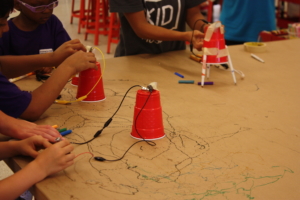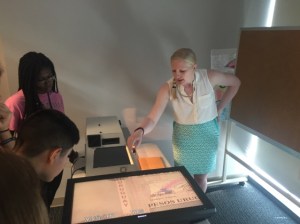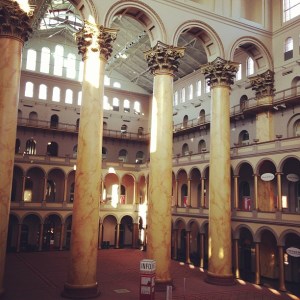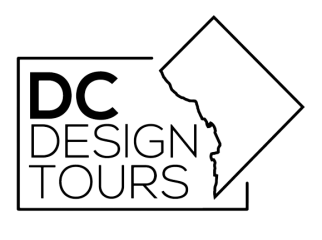STEM Experiences for Kids in DC

STEM (Science, Technology, Engineering, and Math) education has become a focus of learning for young minds. At DC Design Tours, we encourage the next generation of technical and creative thinkers on our kid-friendly walking tours! With a focus on the architecture, planning, and design of Washington DC, our tours bring the backstory of the Nation’s Capital alive. Using storytelling, maps, photos, and secret challenges, DC Design Tours teaches the history behind the brick and mortar to all ages!
Here are four more ways to get your kids involved in STEM in and around Washington DC:
Science at the KID Museum

KID Museum’s Explorer Program encourages kids to think creatively and innovate! Participants learn about the physics of flying, the movement of electricity, and the power of wind by completing various experiential challenges. Rotating between stations, children build different contraptions out of common materials, learning through trial and error. Constructing a flying machine exposes kids to the challenges of aerodynamics, while building a circuit board shows how electricity travels. The “drawbot” writing robot is a study in motors and movement. The “Ping” challenge is a particular favorite, where kids build a massive course of clear pipe throughout the museum and use wind power to send a ping pong ball along the path. The Explorer Program is geared toward elementary and middle school students, and is offered as a 90-minute activity. Groups can also request half or full day customized workshops that focus on design, engineering, electronics, or computer coding. KID Museum is located about 20 minutes outside of Washington, DC in Bethesda, Maryland. www.kid-museum.org
Technology at the International Spy Museum

With hundreds of spy gadgets on display, secret tunnels, touch screens, and the largest collection of espionage artifacts in the world, the International Spy Museum is a big hit with kids. The museum also stands out for the many workshops it offers on STEM topics. In Forensics of Espionage, participants learn about the science of spies by using real-life FBI techniques to root out a double agent! This 45 minute activity, based on accounts of former FBI scientists, is built around a story of intrigue and espionage. Students examine four pieces of evidence from a “dead drop” site, including writing samples, fingerprints, and a muddy boot print, to try and determine which of four suspects is a double agent. The kids then use real forensic analysis equipment, including an Electrostatic Detection Apparatus (ESDA), which employs an electrostatic charge to expose indentations in paper. Working in small teams, students use critical thinking, teamwork, and real-world spy technology to identify the mole in their midst. The International Spy Museum is located in the Chinatown neighborhood of Washington, across the street from the National Portrait Gallery. The museum will be moving to a new home in 2019 at L’Enfant Plaza, just south of the National Mall. www.spymuseum.org
Engineering at the National Building Museum

A visit to the National Building Museum brings architecture, engineering, and history alive in a dazzling display of brick and steel. Originally built as the Pension Office for Civil War veterans, the Building Museum is housed in one of the grandest structures of the 19th century. Today, the museum offers exhibits and programs about the built environment, including hands-on engineering demonstrations. The Discovery Cart program allows kids the opportunity to test out real-world engineering challenges. Participants learn how building materials, gravitational forces, and time affect the longevity and strength of structures. The program focuses on the physics of bridge types or arches and trusses.
Under the direction of museum staff, children work in teams to design, build, and test the strongest structure, either a bridge or an arch. With plenty of space to work out what makes the best bridge, students discover the reality of gravity and challenges of engineering in this STEM focused experience. The National Building Museum is located in the Chinatown neighborhood of Washington, just outside the Judiciary Square metro station. www.nbm.org
Math at the National Cryptologic Museum
The National Cryptologic Museum is a window into the world of code making and code breaking. The museum is located next to the NSA’s headquarters at Fort Meade, and features thousands of machines, media, and artifacts from US cryptologic history. The museum also offers in–depth, STEM-focused programs that open the world of coding to young minds. After an introduction to the museum, students are sent on their own fact-finding scavenger hunt to locate and explain various artifacts in the collection. They examine the world’s earliest super computers, learn how to decode secret German transmissions, and decipher encrypted messages on an actual WWII Enigma Machine. After the scavenger hunt, the kids spend the next hour in the classroom with instructors learning the history, science, and math behind codes. Groups can also add on an optional “Math Talk” with current NSA employees on a variety of subjects, including cryptanalysis, game theory, and cybersecurity. The National Cryptologic Museum is about 45 minutes outside of Washington, DC in Annapolis Junction, Maryland near BWI Airport. www.nsa.gov/about/cryptologic-heritage/museum
DC Design Tours offers public and private tours of Washington DC. Tours are customizable for families, school groups, conferences, and more! Visit dcdesigntours.com to see our schedule of walking tours or get in touch at [email protected] to learn more.
#architecture #STEM #walkingtours #WashingtonDCactivities #kidfriendly #WashingtonDC
